
The Allegheny Portage Railroad was the first railroad constructed through the Allegheny Mountains in central Pennsylvania. It operated from 1834 to 1854 as the first transportation infrastructure through the gaps of the Allegheny that connected the midwest to the eastern seaboard across the barrier range of the Allegheny Front. Approximately 36 miles (58 km) long overall, both ends connected to the Pennsylvania Canal, and the system was primarily used as a portage railway, hauling river boats and barges over the divide between the Ohio and the Susquehanna Rivers. Today, the remains of the railroad are preserved within the Allegheny Portage Railroad National Historic Site operated by the National Park Service.

The Rockville Bridge is the longest stone masonry arch railroad viaduct ever built, with forty-eight 70-foot spans and a total length of 3,820 feet (1,160 m). The bridge crosses the Susquehanna River about 5 miles (8 km) north of Harrisburg, Pennsylvania. The eastern end is in Rockville and the western end is just south of Marysville.
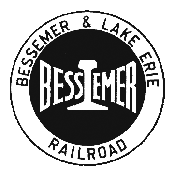
The Bessemer and Lake Erie Railroad is a class II railroad that operates in northwestern Pennsylvania and northeastern Ohio.

The Smithfield Street Bridge is a lenticular truss bridge crossing the Monongahela River in Pittsburgh, Pennsylvania, USA.
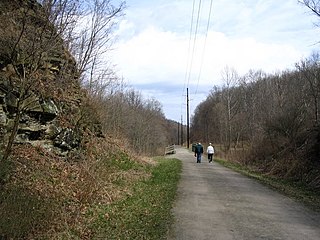
The Montour Trail is a multi-use recreational rail trail near Pittsburgh, Pennsylvania. It was formerly the Montour Railroad.

The Delair Bridge is a railroad bridge with a vertical-lift section that crosses the Delaware River between Philadelphia, Pennsylvania, and Pennsauken Township, New Jersey, just south of the Betsy Ross Bridge. The two-track bridge is part of Conrail Shared Assets Operations and is jointly used by Norfolk Southern Railway and CSX Transportation freight trains, as well as by the New Jersey Transit Atlantic City Line service.
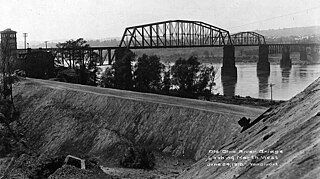
The Beaver Bridge is a rail bridge spanning the Ohio River between Monaca and Beaver, Pennsylvania. It consists of two spans: a southern cantilever through truss of 769 feet (234 m) with 320-foot (98 m) anchor arms; and a northern camelback through truss of 370 feet (110 m). The bridge currently carries two tracks of CSX Transportation.

The Morrisville–Trenton Railroad Bridge is a rail bridge across the Delaware River between Morrisville, Pennsylvania and Trenton, Mercer County, New Jersey, United States.

The Hot Metal Bridge is a truss bridge in Pittsburgh, Pennsylvania, that crosses the Monongahela River. The bridge consists of two parallel spans on a single set of piers: the former Monongahela Connecting Railroad Bridge, built in 1887, on the upstream side and the former Hot Metal Bridge, built in 1900, on the downstream side. The Monongahela Connecting Railroad Bridge carried conventional railroad traffic, while the Hot Metal Bridge connected parts of the J&L Steel mill, carrying crucibles of molten iron from the blast furnaces in ladle transfer cars to the open hearth furnaces on the opposite bank to be converted to steel. During World War II 15% of America's steel making capacity crossed over the Hot Metal Bridge, up to 180 tons per hour. The upstream span was converted to road use after a $14.6 million restoration, and opened by Mayor Tom Murphy with a ceremony honoring former steel workers on June 23, 2000. The bridge connects 2nd Avenue at the Pittsburgh Technology Center in South Oakland with Hot Metal Street in the South Side. The downstream span reopened for pedestrian and bicycle use in late 2007 after two years of work. The Great Allegheny Passage hiker/biker trail passes over this bridge as it approaches Pittsburgh's Golden Triangle area.
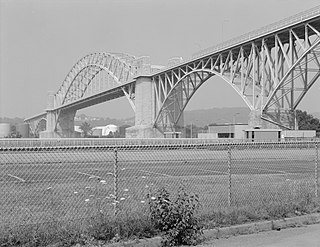
The McKees Rocks Bridge is a steel trussed through arch bridge which carries the Blue Belt, Pittsburgh's innermost beltline, across the Ohio River at Brighton Heights and McKees Rocks, Pennsylvania, west of the city.

The Ohio Connecting Railroad Bridge is a steel bridge which crosses the Ohio River at Brunot's Island at the west end of Pittsburgh, Pennsylvania, United States. It consists of two major through truss spans over the main and back channels of the river, of 508 feet (155 m) and 406 feet (124 m) respectively, with deck truss approaches.

Pittsburgh, surrounded by rivers and hills, has a unique transportation infrastructure that includes roads, tunnels, bridges, railroads, inclines, bike paths, and stairways.

The Union Railroad is a Class III switching railroad located in Allegheny County in Western Pennsylvania. The company is owned by Transtar, Inc., which is itself a subsidiary of Fortress Transportation and Infrastructure Investors, after being purchased from United States Steel in 1988. The railroad's primary customers are the three plants of the USS Mon Valley Works, the USS Edgar Thomson Steel Works, the USS Irvin Works and the USS Clairton Works.
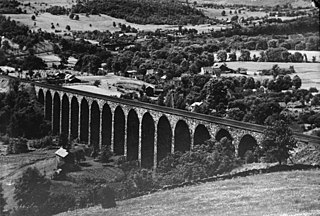
Starrucca Viaduct is a stone arch bridge that spans Starrucca Creek near Lanesboro, Pennsylvania, in the United States. Completed in 1848 at a cost of $320,000, it was at the time the world's largest stone railway viaduct and was thought to be the most expensive railway bridge as well. Still in use, the viaduct is listed on the National Register of Historic Places and is designated as a National Historic Civil Engineering Landmark.

The Kinzua Bridge or the Kinzua Viaduct was a railroad trestle that spanned Kinzua Creek in McKean County in the U.S. state of Pennsylvania. The bridge was 301 feet (92 m) tall and 2,052 feet (625 m) long. Most of its structure collapsed during a tornado in July 2003.

The Safe Harbor Bridge also known as the Safe Harbor Trestle, Port Road Bridge and the Enola Low Grade Line Steel Trestle is a steel deck truss trestle that spans the Conestoga River at Safe Harbor, Pennsylvania near the Susquehanna River for the Port Road Branch and the former Columbia and Port Deposit Railroad along the Susquehanna River. It was built in 1905 for the Atglen and Susquehanna Branch (A&S), also known as the "Low Grade Branch", of the Pennsylvania Railroad (PRR).

The Herr's Island Railroad Bridge, also known as the West Penn Railroad Bridge, is a truss bridge across the Allegheny River in the United States between the Pittsburgh neighborhoods of Troy Hill and Herrs Island.
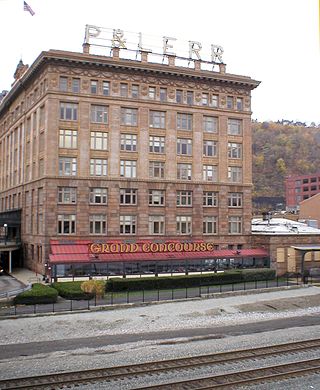
The Pittsburgh & Lake Erie Railroad Station, now Landry's Grand Concourse restaurant in Station Square Plaza in Pittsburgh, Pennsylvania, is an historic building that was erected in 1898. It was listed on the National Register of Historic Places in 1974.

Bridge in Portage Township is a historic stone arch bridge located at Portage Township in Cambria County, Pennsylvania. It was built by the Allegheny Portage Railroad in 1832, and is an 18-foot-long (5.5 m) bridge, with a semi-circular arch. It is built of coursed ashlar and crosses Bens Creek.

Lilly Bridge is a historic stone arch bridge located at Lilly in Cambria County, Pennsylvania. It was built by the Allegheny Portage Railroad in 1832, and is an 18-foot-long (5.5 m) bridge, with an elliptical shape and curved wingalls. It is built of roughly squared ashlar and crosses Burgoon Run.





















